Home Surge Protection
Today’s homes are filled with more and more sensitive electronics and protecting each one individually is expensive and messy.
Did you know that up to 80% of power surges come from inside your home? According to NEMA, common household devices like A/C compressors, heating elements, and switch-mode power supplies are the primary culprits. While lightning and power grid switching are well-known external threats, new and potentially more damaging risks—like electromagnetic pulses (EMPs) and solar flares (CMEs)—are on the rise.
Most electronics in the U.S. are built for 120V AC. Even small spikes above this level can slowly wear down internal components, especially power supplies, leading to unexpected failures and costly replacements.
Home insurance might cover some surge damage, but it won’t cover the inconvenience or the downtime. That’s why investing in reliable surge protection isn’t just smart—it’s essential. It’s a simple step that can protect your electronics, save you money, and give your customers peace of mind.

Type 1 Surge Protector
This type of surge protector (also called Class I SPD – Surge Protection Devices) are devices designed to protect electrical installations and equipment from high-energy external surges, such as direct lightning strikes or power surges originating from utility switching.
If you’re setting up a full surge protection strategy, Type 1 is the first layer, followed by Type 2 and Type 3 for complete protection.
🔧 Key Characteristics of Type 1 Surge Protectors:
| Feature | Description |
| Purpose | Protection against high-energy surges, especially from direct lightning strikes. |
| Installation Point | Typically installed at the main service entrance of a building (e.g., between the utility pole and the building’s electrical panel). |
| Impulse Current Rating (Iimp) | Can handle large surge currents, often 10–25 kA per phase (based on 10/350 µs waveform). |
| Standards | Compliant with IEC 61643-11 (Class I SPD) or UL 1449 (Type 1 SPD in the U.S.). |
| Connection | Installed before the main breaker (line side) or in combination with Type 2 SPDs. |

🏠 Where You’d Use a Type 1 SPD:
- In buildings located in high lightning-risk areas.
- In commercial and industrial settings where power reliability is critical.
- In any facility needing whole-building surge protection starting at the service entrance.
🔌 How It’s Different from Other Types:
|
Type |
Purpose |
Location |
|
Type 1 |
Protects against external surges (e.g., lightning) |
Main service entrance |
|
Type 2 |
Protects against internal surges (e.g., switching, motor loads) |
Main or sub-distribution boards |
|
Type 3 |
Fine protection for sensitive electronics |
Near end-use devices (e.g., power strips) |

240VAC Split-Phase Surge Protector 50kA
SP240V50KA
$89.00

240VAC Split-Phase Surge Protector 65kA
SP240V65KA
$99.00

240VAC Split-Phase Surge Protector 100kA
SP240V100KA-B
$159.00

240VAC Split-Phase Surge Protector 200kA
SP240V200KA
$249.00
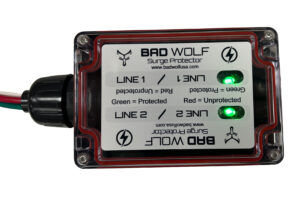
240VAC Split-Phase Surge Protector 225kA
SP240225KA
$399.00
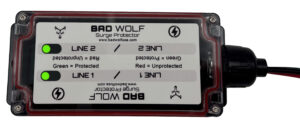
240VAC Split-Phase Surge Protector 400kA
SP240V400KA
$499.00
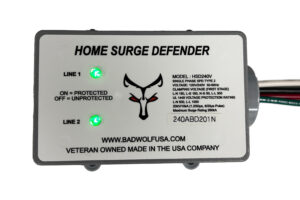
240VAC Split-Phase Surge Protector 260kA
HSD240V
$329.00
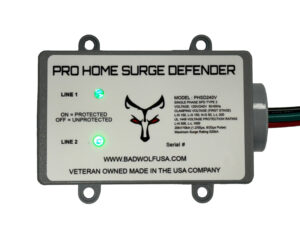
240VAC Split-Phase Surge Protector 520kA
PHSD240V
$429.00
Type 2 Surge Protector
These devices are designed to protect electrical installations and equipment from transient overvoltages, typically caused by indirect lightning strikes or switching operations in the power grid. They are usually installed at the main distribution board (electrical panel) of a building. Modern homes and businesses use equipment like computers, TVs, HVAC systems, and industrial control devices that are sensitive to voltage spikes. Type 2 SPDs limit overvoltage to a level that these devices can tolerate.
🔹 Typical Applications
- Residential and commercial buildings
- Industrial facilities
- Data centers
- Electrical panels serving sensitive electronics

When to Use Type 2:
- As a middle layer in a multi-stage surge protection system.
- In buildings connected to overhead power lines.
- In areas prone to power fluctuations or lightning.
Key Characteristics of Type 2 Surge Protectors:
- Installation Location: Main service panel (downstream of the Type 1 device if present).
- They protect downstream systems from residual surges that make it past a Type 1 device (or from grid-induced surges if no Type 1 is present).
- Protection Level: Medium-level protection — they limit voltage surges to a level that downstream equipment can tolerate.
- Application: Suitable for residential, commercial, and light industrial installations.
- Voltage Waveform Tested Against: 8/20 µs waveform (simulates the kind of surge from switching or nearby lightning).
- Response Time: Fast (in nanoseconds), enough to catch transients before they affect devices.
Key Characteristics of Type 2 Surge Protectors:
- Installation Location: Main service panel (downstream of the Type 1 device if present).
- Protection Level: Medium-level protection — they limit voltage surges to a level that downstream equipment can tolerate.
- Application: Suitable for residential, commercial, and light industrial installations.
- Voltage Waveform Tested Against: 8/20 µs waveform (simulates the kind of surge from switching or nearby lightning).
- Response Time: Fast (in nanoseconds), enough to catch transients before they affect devices.
Comparison with Other Types:
|
Type |
Location |
Purpose |
Surge Origin |
Voltage Waveform |
|
Type 1 |
Before/at main breaker (service entrance) |
Handles direct lightning strikes or high-energy surges |
External (lightning, power grid) |
10/350 µs |
|
Type 2 |
Main distribution panel |
Protects electrical systems and devices |
Indirect lightning, switching |
8/20 µs |
|
Type 3 |
Close to equipment (e.g., outlets) |
Fine protection for sensitive electronics |
Residual surges |
Combination wave |
Type 3 Surge Protectors
These types of surge protectors, also known as point-of-use surge protective devices (SPDs), are designed to protect individual electronic devices or appliances within a building. Typically installed at a maximum conductor length of 10 meters (30 feet) from the electrical device to be protected. They are the final layer of surge protection in a multi-tiered surge protection system (Type 1 → Type 2 → Type 3).
Key Characteristics of Type 3 Surge Protectors:
-
Location: Installed close to the protected equipment—typically at wall outlets or integrated into power strips or uninterruptible power supplies (UPS).
-
Purpose: They protect sensitive electronics (like TVs, computers, gaming systems, etc.) from residual surges that pass through the main service panel or are introduced inside the building.
-
Surge Capacity: Lower than Type 1 or 2 SPDs. They handle surges in the range of a few hundred to a few thousand amps, enough to stop small spikes and residual surges.
-
Installation: Plug-and-play (no electrician needed).

Examples:
-
Surge protector power strips
-
Wall-tap surge suppressors
-
Surge-protecting USB chargers or plug adapters
Comparison with Type 1 and Type 2 SPDs:
| Type | Location | Purpose | Surge Capacity | Installation |
|---|---|---|---|---|
| Type 1 | Service entrance (before main breaker) | Protection from external surges (e.g., lightning) | Very high | Installed by electrician |
| Type 2 | Main distribution panel | Protection from internal surges (e.g., large appliances) | Moderate to high | Installed by electrician |
| Type 3 | Point-of-use (e.g., outlet strip) | Protection for individual devices | Low to moderate | Plug-in |

120VAC Surge Protector 120kA
SSP120V
$129.00
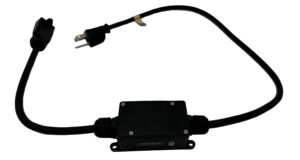
120VAC Surge Protector 50kA
PSP120V
$129.00

120VAC Surge Protector 65kA
SP120V65KA
$229.00

